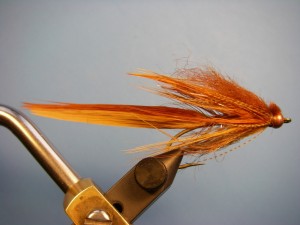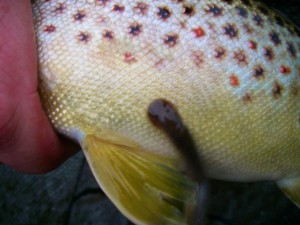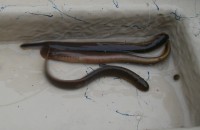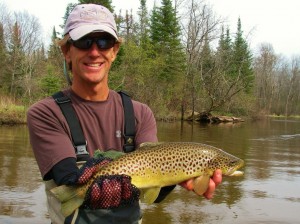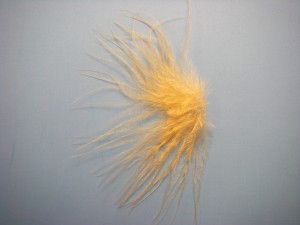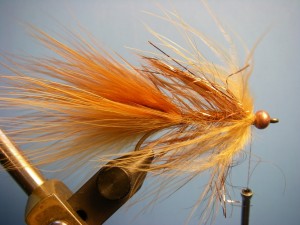The Chestnut Lamprey is an important food source for the Manistee and many Northern Michigan trout rivers. This is what led me to develop the Lamprey Leech fly pattern. I wanted a pattern that was easy to tie and had lots of motion which resulted in this fun-to-fish and effective pattern. The Lamprey Leech has become my go-to fly when the fish aren’t overly active or are acting lethargic and deserves a place in your fly box.
Each year customers bring a significant number of fish to the net with numerous Chestnut Lampreys attached to them – I can’t help but think that the fish remember these parasites and revengefully attack them when given the chance.
Rich in protein and provocative swimmers, the lamprey often swims against the current making themselves easily noticed and vulnerable to predatory trout.
Late spring and early summer is when these 4-6 inch lampreys are most active and abundant, making them significant to the fly angler. While the months of May and June are optimal, this pattern has caught fish throughout the year perhaps because of its resemblance to worms and night crawlers, or because of its profile and action.
How to fish the Lamprey Leech Fly
Since it is tied with a bead-head, anglers can fish this fly on both a floating line or a sink-tip. The floating line approach is a fun way to fish shallow water with moderate cover, allowing you to work the fly in and around that cover.
Mends in either type of fly line are very important as it gets this fly to work in conjunction with the current to maximize its movement without stripping it out of the targeted water. Popping or snapping the rod tip upwards like a jig, combined with mends, can really seductively work the pattern as can two, quick strips with a long pause in between.
To learn more on an alternative presentation and approach to streamer fishing, read Seductive Streamer Fishing.
Lamprey Leech Recipe
Hook: TMC 200R #4
Thread: Uni 6/0 Camel
Bead: 3/16″ Copper
Tail: Marabou – Blood Quill Ginger and Golden Brown
Body: Natural Brown Strung Saddle Hackle
Flash: UV Polar Chenille – Copper
Wing: Same as tail
Collar: Mallard Dyed Wood Duck Flank
Topping: Sheep Hair – Rust
Tying Instructions
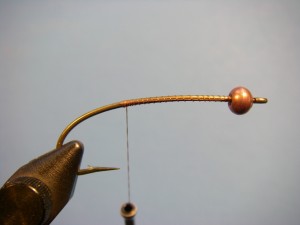 Step 1. Place bead on hook and place in vise. Start a thread base from behind the bead to above the hook point.
Step 1. Place bead on hook and place in vise. Start a thread base from behind the bead to above the hook point.
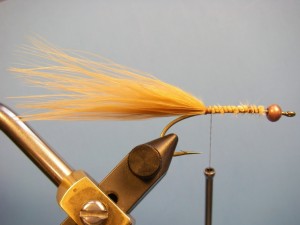 Step 2. Tie in ginger marabou so it extends close to twice the length of the hook.
Step 2. Tie in ginger marabou so it extends close to twice the length of the hook.
I typically remove the end of the feather to keep it long and lanky to maximize motion.
Wrap on top of the hook extending 2/3 rds up the shank.
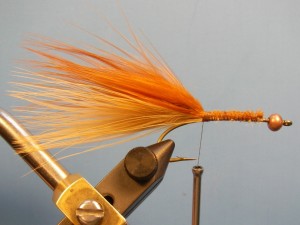 Step 3. Repeat Step 2 with the darker marabou so it is the same length.
Step 3. Repeat Step 2 with the darker marabou so it is the same length.
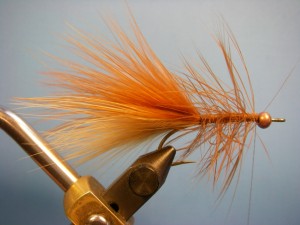 Step 4. Tie in a very webby (almost schlappen-like) saddle hackle by the tip and wind up over the marabou.
Step 4. Tie in a very webby (almost schlappen-like) saddle hackle by the tip and wind up over the marabou.
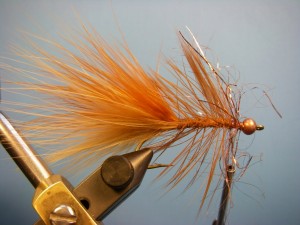 Step 5. Tie in the Polar Chenille and make one or two wraps depending on the amount
Step 5. Tie in the Polar Chenille and make one or two wraps depending on the amount
of flash desired. Use your bodkin to pick out any trapped fibers.
Step 6. Use just a bit of marabou and tie in so the tips extend past the bend of the hook.
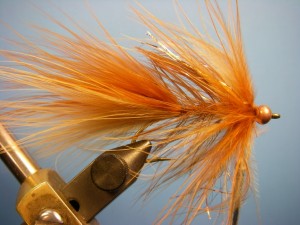 Step 7. Repeat Step 6 with the darker marabou feather, using just a little more product but remaining sparse.
Step 7. Repeat Step 6 with the darker marabou feather, using just a little more product but remaining sparse.
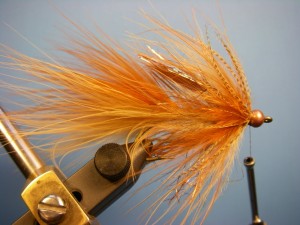 Step 8. Tie in mallard flank by the tip, and fold the feather so both sides of the stem
Step 8. Tie in mallard flank by the tip, and fold the feather so both sides of the stem
sweep backwards. Make 1 to 1.5 turns to create the collar.
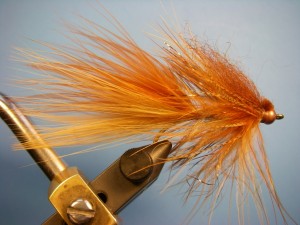 Step 9. Tie in a clump of sheep hair on the top half of the fly where the tips extend to above
Step 9. Tie in a clump of sheep hair on the top half of the fly where the tips extend to above
the hook barb. Tie off and apply head cement.
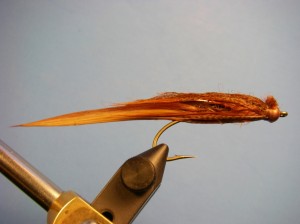 The wet look of the Lamprey Leech. Lots of motion and a great profile.
The wet look of the Lamprey Leech. Lots of motion and a great profile.

